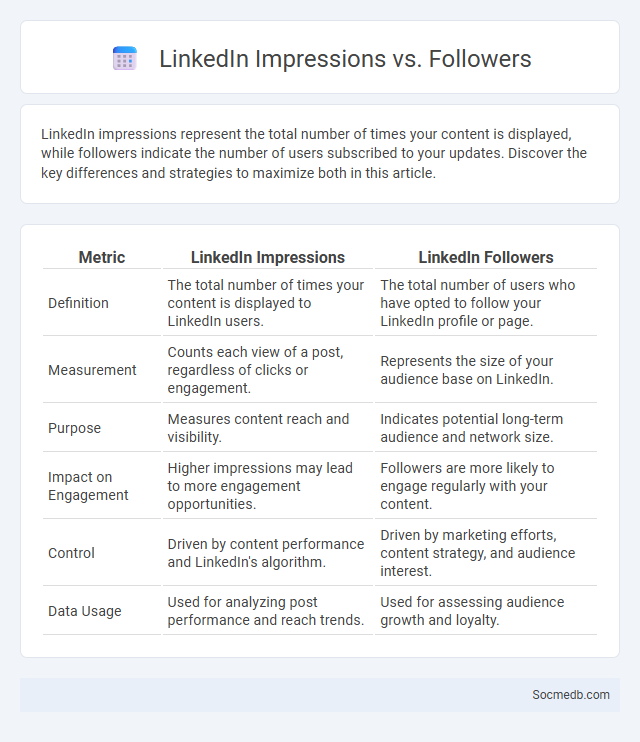
Photo illustration: LinkedIn Impressions vs Followers
LinkedIn impressions represent the total number of times your content is displayed, while followers indicate the number of users subscribed to your updates. Discover the key differences and strategies to maximize both in this article.
Table of Comparison
| Metric | LinkedIn Impressions | LinkedIn Followers |
|---|---|---|
| Definition | The total number of times your content is displayed to LinkedIn users. | The total number of users who have opted to follow your LinkedIn profile or page. |
| Measurement | Counts each view of a post, regardless of clicks or engagement. | Represents the size of your audience base on LinkedIn. |
| Purpose | Measures content reach and visibility. | Indicates potential long-term audience and network size. |
| Impact on Engagement | Higher impressions may lead to more engagement opportunities. | Followers are more likely to engage regularly with your content. |
| Control | Driven by content performance and LinkedIn's algorithm. | Driven by marketing efforts, content strategy, and audience interest. |
| Data Usage | Used for analyzing post performance and reach trends. | Used for assessing audience growth and loyalty. |
Understanding LinkedIn Impressions
LinkedIn impressions represent the number of times your content is displayed on users' feeds, providing insights into your post's visibility and reach. Tracking these impressions helps identify which types of content resonate with your network, enabling strategic adjustments to boost engagement. Analyzing the patterns behind your LinkedIn impressions allows you to tailor your professional presence and expand your audience effectively.
Defining LinkedIn Followers
LinkedIn followers are individuals who subscribe to your professional updates, enabling your content to reach a targeted audience interested in your industry expertise. Growing your LinkedIn followers enhances your networking opportunities and increases visibility within your professional community. Your follower count directly impacts your influence on the platform, making it essential to engage meaningfully with your audience.
Impression vs Impressions: Semantic Differences
Understanding the semantic differences between "Impression" and "Impressions" in social media analytics is crucial for measuring Your content's performance accurately. An "Impression" refers to a single instance of content being displayed to a user, while "Impressions" indicate the total count of these instances across all users, reflecting overall visibility. Tracking both metrics helps optimize Your marketing strategies by distinguishing individual exposure from aggregate reach.
How LinkedIn Impressions Are Calculated
LinkedIn impressions are calculated based on the total number of times a post or advertisement is displayed to users on their feeds, regardless of whether they interact with it. Each appearance counts as one impression, including views from multiple devices or repeated views by the same user. This metric helps businesses and professionals gauge content visibility and reach within LinkedIn's professional network.
What Growing Followers Means for Your LinkedIn Presence
Growing followers on LinkedIn significantly boosts your professional visibility and credibility in your industry. A larger audience increases engagement opportunities, leading to meaningful connections, potential collaborations, and career advancements. Consistent content sharing and authentic interaction enhance your LinkedIn presence, positioning you as a thought leader.
The Relationship Between Impressions and Followers
Impressions measure the total number of times content is displayed, serving as a key indicator of visibility, while followers represent the audience base that repeatedly engages with a profile, reflecting long-term interest. A high impression count does not always translate to follower growth, as engagement quality and content relevance significantly impact follower acquisition. Monitoring the ratio of impressions to followers helps optimize content strategies to convert casual viewers into loyal supporters on social media platforms.
Factors That Influence LinkedIn Impressions
LinkedIn impressions are significantly influenced by factors such as the relevance of content to the target audience, the timing and frequency of posts, and user engagement metrics including likes, comments, and shares. Optimizing profile completeness, utilizing industry-specific keywords, and leveraging multimedia elements like images and videos also enhance visibility. Advanced LinkedIn algorithms further prioritize content from active users with strong network connections and consistent posting patterns.
Best Practices to Increase LinkedIn Followers
To increase your LinkedIn followers, consistently share high-quality, industry-relevant content that engages your target audience and encourages interaction. Optimize your profile with a clear, professional photo and compelling headline, while actively participating in LinkedIn groups and discussions to boost visibility. Posting regularly during peak times and utilizing hashtags strategically helps expand your reach and attract more followers organically.
Evaluating Success: Impressions or Followers?
Measuring social media success depends on specific goals, where impressions indicate content reach and brand visibility, while followers represent potential long-term audience engagement and community growth. High impressions demonstrate widespread content exposure but may not translate into active interaction or loyalty, whereas a substantial follower count often correlates with sustained interest and consistent engagement metrics. Optimizing strategy involves balancing impression-driven campaigns for brand awareness with follower-focused efforts to cultivate meaningful relationships and drive conversions.
Key Metrics to Track in LinkedIn Analytics
LinkedIn Analytics provides essential metrics such as visitor demographics, engagement rate, and follower growth to help you understand your audience's behavior and preferences. Monitoring post views, click-through rates, and conversion metrics allows you to optimize your content strategy for better reach and impact. Tracking these key performance indicators ensures your LinkedIn presence effectively supports your professional goals and networking efforts.
 socmedb.com
socmedb.com